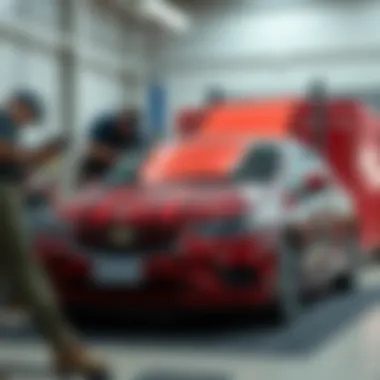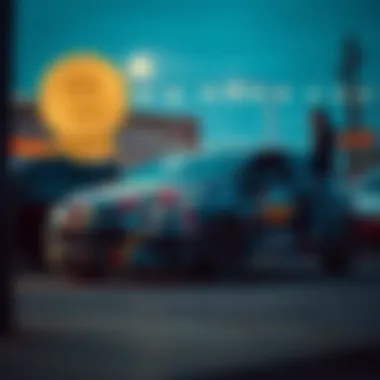Cost Factors for Wrapping Your Chevy Cruze Explained


Intro
In today's automotive world, the appearance of a vehicle is often just as important as its performance. For many Chevy Cruze owners, wrapping the car has become an appealing method to not only enhance its aesthetic value but to also protect the original paint job underneath. However, diving into the world of vehicle wrapping raises important thoughts about what the process entails, particularly the costs involved. Not only do you need to consider material quality, but also factors like labor expenses, regional differences, and even the current market trends that can significantly influence the overall expense.
With a rising number of car enthusiasts looking to personalize their rides while keeping costs manageable, understanding the intricacies of wrapping a Chevy Cruze can be quite beneficial. This article aims to break down these complex considerations, ensuring that car owners and prospective wrappers can make informed decisions that balance quality with budget.
Preface to Vehicle Wrapping
When it comes to transforming the look of our vehicles, vehicle wrapping has become a popular route among car enthusiasts and everyday drivers alike. Not only does it offer an avenue for personalization, but it also has implications for the vehicle's protection and resale value. This section sets the stage for understanding the multifaceted aspects of wrapping a Chevy Cruze, encompassing the reasons why people opt for this enhancement, its practical benefits, and key considerations.
Definition of Vehicle Wrapping
Vehicle wrapping is essentially the process of covering a car's exterior with a large vinyl graphic or decal. This can encapsulate everything from simple logos to intricate designs that can transform an ordinary car into a mobile billboard or a unique piece of art. In the case of a Chevy Cruze, wrapping serves dual purposes: aesthetic enhancement and protection for the original paint underneath. The materials used in vehicle wraps are often high-quality vinyl, engineered to withstand the rigors of daily driving, UV light, and various environmental factors.
Popularity of Vehicle Wraps
The rise in popularity of vehicle wraps can be traced to several factors, each contributing to their appeal:
- Customizability: A vehicle wrap offers unparalleled flexibility in design, allowing owners to express their individuality. Unlike a paint job, which can be a costly and permanent commitment, a wrap is a more temporary solution that can be updated or removed as desired.
- Cost-Effectiveness: Compared to a full paint job, wrapping can be a more budget-friendly option, particularly for those looking to invoke a significant change without breaking the bank. While the initial investment can still be hefty, it often pales in comparison to traditional methods of customization.
- Quick Installation: Professional installation can often be completed in a matter of days rather than weeks, minimizing downtime for drivers.
- Durability: High-quality vinyl wraps can protect a vehicle's original paint from scratches, fading, and other potential damages, thus enhancing the vehicle's longevity.
"Vehicle wraps not only change a car's appearance, but also help protect its original paint job, making it a favored choice among owners of all types of vehicles."
In summary, vehicle wrapping is not just a trend but a practical solution for drivers looking to make a statement while protecting their investment. As we delve deeper into the costs associated with wrapping a Chevy Cruze, it is essential to appreciate these underlying factors that make wrapping an attractive option.
Factors Influencing Wrap Cost
When it comes to wrapping a Chevy Cruze, several factors come into play that can significantly affect the total cost. Understanding these elements is crucial for owners who want to elevate their vehicle's look without breaking the bank. The cost of vehicle wrapping is not just about picking a color and design; it involves discerning various layers of materials, labor, and the complexity tied to the specific vehicle in question. Additionally, the financial outlay can vary by region, making it essential to get the facts straight before diving in.
Material Choices
Vinyl Wrap Types
Vinyl wrap types play a crucial role in determining the overall aesthetic and durability of the wrapping process. There are several kinds of vinyl, each with distinct characteristics. For instance, there are cast vinyls known for their flexibility and durability, making them suitable for intricate curves and textures. On the other hand, calendared vinyls are more budget-friendly but may not perform as well in terms of longevity or adaptability to complex surfaces. Some car owners might choose a cast vinyl for its durability in harsh weather conditions, which adds a layer of protection to their Chevy Cruze, ensuring it looks sharp for years to come.
Quality Variations
Quality variations among vinyl wraps can create a sizable disparity in prices. Higher-quality wraps typically last longer and require less maintenance. They often feature advanced technologies that enhance their resistances, such as UV protection and weatherproofing. While it might be enticing to go for a cheaper option, the long-term costs associated with frequent replacements and maintenance can add up quickly. Opting for premium vinyl materials could mean an initial higher investment but can lead to savings over time.
Color Selection
Choosing the right color for your wrap is not just a personal preference but also a significant cost factor. Unique or custom colors, particularly vibrant and metallic hues, usually can drive up the price. This is due to the manufacturing process of these specialty colors which involves more intricate procedures. A classic color might be more economical and generally easier to apply, but a custom shade can make a bold statement that reflects the personality of the owner, ensuring the vehicle stands out wherever it goes.
Labor Costs
Experience of Installers
The experience level of installers is another major consideration when wrapping a Chevy Cruze. A seasoned installer brings a depth of knowledge that can greatly influence the quality of the wrap. Not only do they utilize techniques that yield a cleaner finish, but they also tend to make fewer mistakes that could lead to extra charges later on. While opting for a less experienced installer might cut costs at first, it could lead to additional expenses if the installation results in problems down the line.


Complexity of Installation
The complexity of the installation process can also drive costs. If your wrap design involves complicated graphics or precise placements, it will likely require more time and skill to install. This complexity can inflate labor costs. On the flip side, a simple, clean design can be executed more quickly, saving clients money in labor. Knowing how intricate you want your design can help set realistic expectations regarding both time and financial outlay.
Regional Labor Rates
Regional labor rates can pose a significant influence on the total cost of wrapping your car. In metropolitan areas, labor costs tend to be higher because of increased demand and living expenses. Conversely, in rural regions, you might find more competitive rates due to lower demand. Understanding these differences helps you make informed decisions about your wrap and choose a location that matches your budget.
Vehicle Size and Complexity
Surface Area Considerations
The size and complexity of the Chevy Cruze determine not only the amount of material required but also the labor involved in the installation. A larger vehicle will necessitate more material, naturally leading to higher costs. Furthermore, the surface area can dictate how many seams or cuts need to be made, which also adds to the time and effort required for a successful wrap. The thoughtful consideration of these aspects is crucial for accurate budgeting.
Wrap Coverage Types
Wrap coverage types are essential to understand, as they dictate how much of the vehicle will be covered and at what cost. A full wrap, for instance, will cover all visible areas, while partial wraps may target only certain sections. Although partial wraps can reduce initial costs, they may not always provide the same level of protection or visual impact. The choice between full and partial wraps should be guided by personal goals for the vehicle’s appearance and protection.
Average Costs for a Chevy Cruze Wrap
Understanding the average costs associated with wrapping a Chevy Cruze is vital for any car owner considering a vehicle wrap. Pricing can vary significantly based on multiple factors, making it essential to grasp the elements that affect these costs. Knowledge of what influences these expenses not only aids in budget planning but also helps in making informed choices about the wrapping process.
When weighing the decision to wrap your Chevy Cruze, the financial aspect cannot be overlooked. From materials to labor, every ounce plays a part in the overall pricing. The breakdown of these costs gives potential customers a transparent view of what to expect, allowing them to make choices that align with their preferences and financial situations.
Cost Breakdown
Material Costs
Material costs form a fundamental aspect of the overall expense when wrapping a Chevy Cruze. The type of vinyl used, along with its quality, can cause costs to fluctuate greatly. High-quality vinyl materials, such as 3M or Avery Dennison, are often favored due to their durability and aesthetic appeal. The right material is crucial because they not only determine the look of the wrap but also its longevity.
A unique feature of these material costs is that they can be tailored to individual needs. For instance, if someone opts for a matte finish rather than a glossy one, it might come at a different price point. This flexibility allows car owners to customize their wrap according to personal taste without breaking the bank, striking a balance between quality and affordability. However, cheaper vinyl options could lead to premature peeling or fading, which could ultimately result in higher long-term costs.
Labor Expenses
Labor expenses represent another significant factor when considering wrapping the Chevy Cruze. The complexity of the installation often dictates these costs. Employing an experienced technician might come at a premium, but it frequently pays off in the quality of the finished product. Experienced installers have the skills needed to handle intricate parts of the wrap, ensuring that the final appearance is without flaws.
An interesting point about labor expenses is that they vary regionally. In metropolitan areas, where demand is high, labor costs can skyrocket. Alternatively, in smaller towns, prices may be more reasonable. This variability means that shoppers should scout around when seeking knowledgeable installers. By finding a reputable workshop nearby, you can get both expertise and value for money.
Additional Fees
Additional fees can often be an afterthought for customers considering a vehicle wrap, yet they contribute to the overall cost substantially. Factors such as pre-wrapping preparations—like cleaning and minor repairs—can add to the expense. Additionally, if you're looking to wrap certain parts like mirrors or bumpers, the costs can increase as these are treated differently compared to standard wrapping surfaces.
A key benefit of understanding these additional fees is that they allow for better financial planning. Customers can prepare for potential costs that could catch them off-guard, ensuring there are no unwelcome surprises down the road. Furthermore, clarity around these expenses helps in making educated decisions about the desired wrap configuration and extra additions that can enhance the final outcome.
Case Studies
Basic Wrap Examples


Basic wrap examples can provide a window into what consumers can expect in terms of pricing and results. Taking a straightforward approach with a single color or simple pattern often results in lower costs. For individuals searching for a clean look without the frills, a basic wrap can serve its purpose well.
One advantage of a basic wrap is that it typically requires less labor, meaning lower installation fees. The simplicity not only keeps costs in check but also allows for quick turnaround times. However, it’s important to note that while these wraps might be economically friendly, they offer limited aesthetic customization compared to more intricate designs.
Full Coverage Wrap Examples
On the other hand, full coverage wrap examples showcase the extensive protection and aesthetic options available for those willing to invest a bit more. A full wrap often involves covering every inch of the vehicle, including curves and difficult shapes, demanding more time and skill from the installer.
One of the standout features of a full wrap is the dramatic transformation it can offer. Whether a bold color shift or an intricate design, the possibilities are vast. However, this luxury comes at a price. Full coverage typically involves a significant increase in both material and labor costs, making it a more hefty investment. Still, many find the enhancement worth every penny, given the considerable visual impact it achieves.
In summary, grasping the average costs for a Chevy Cruze wrap is essential for informed decision-making. From breaking down material expenses to weighing labor and additional fees, each element plays a role in creating the perfect wrap that aligns with both aesthetic desire and budget constraints.
Benefits of Wrapping a Chevy Cruze
Wrapping your Chevy Cruze goes beyond just changing its look; it's about adding layers of value that enhance the vehicle in various ways. Car owners today want their vehicles to speak to their personality and style, but they also consider practical aspects like protection and maintenance. The benefits of wrapping your vehicle are numerous and merit careful examination.
Aesthetic Customization
When someone sees a Chevy Cruze with a fresh wrap, the difference is striking. It's not just about color; it’s about texture, finish, and overall vibe. With an array of textures and finishes available—like gloss, matte, and metallic—car enthusiasts can tailor their rides to reflect individuality. Forget the days when painting meant a weeks-long process, often leaving you without your car for days. With wraps, the customization potential is vast, from vivid racing stripes to understated satin shades.
You can also opt for patterns or even a digital print to make your vehicle stand out in a crowd. Just remember, styles change, and while your wrap can be switched out in a matter of days, a paint job isn’t so forgiving. The versatility of vehicle wraps gives owners more freedom than they ever had with traditional paint.
Protection of Original Paint
One fundamental benefit of a good vehicle wrap is the safeguard it provides for the original factory paint. Exposure to the elements—UV rays, road debris, and winter salt—can wear down paint over time, and the cost of repainting can be enough to break the bank. Aluminum and steel bodies of cars are vulnerable, and protecting them can save you money in the long run.
A wrap acts as a protective layer, shielding the paint from scratches, dents, and fading. Plus, when the wrap is eventually removed, the factory finish beneath is often still in pristine condition, making the vehicle look like new. This is particularly valuable if you’re planning to sell or trade-in your Cruze down the line.
Potential Resale Value Enhancement
Looking at the potential resale value is key for anyone considering wrapping their vehicle. A vehicle protected by a wrap usually fetches a better price compared to one exposed to the wear and tear of the road. Buyers often perceive wrapped vehicles as having been protected, which can enhance their appeal.
Furthermore, if a unique and eye-catching wrap is installed, it can differentiate your Chevy Cruze from the others on the market.
"A well-done wrap reflects attention to detail and care, which can significantly boost buyer interest."
By appealing to consumer tastes, and if the wrap is kept in good shape, the likelihood of attracting a buyer increases. You can even choose to have the wrap in a neutral or widely-accepted color to enhance marketability. This thoughtful approach to customization not only elevates your driving experience but also ensures you make a smart investment when it’s time to sell.
In summary, wrapping a Chevy Cruze offers extensive advantages, from aesthetic personalization to protecting the original paint and enhancing resale value. Each of these factors plays a crucial role in how you perceive your vehicle and its long-term financial implications.
Comparison with Other Customization Options
When considering how to enhance a Chevy Cruze, vehicle wrapping often stands out as a preferred choice among car enthusiasts and owners. Understanding how it stacks up against other customization options can help you make an informed decision based on aesthetics, durability, and cost. The landscape of vehicle personalization spans various avenues, including paint jobs, aftermarket accessories, and wraps, each with its distinct advantages and drawbacks.
Paint vs. Wrap
One of the most significant debates among car aficionados is whether to wrap a vehicle or opt for traditional paint. Each method comes with its own set of features that cater to different preferences.


Cost: Generally, a quality paint job can hit your wallet harder than a wrap. Professional paint jobs, especially those involving intricate designs or multiple layers, can cost a pretty penny. In contrast, wrapping offers a more budget-friendly alternative while still providing substantial visual impact.
Durability: Wraps might not have the same longevity as high-end paint jobs, but they offer a reliable shield against minor abrasions and UV exposure, meaning the original paint is better preserved underneath. On the flip side, high-quality automotive paint often exceeds the lifespan of wraps when properly cared for.
Flexibility: When it comes to customization, wraps take the cake. Want to change your car's look every few years without breaking the bank? Wraps allow for quicker changes in style or color. Paint alterations tend to cost more time and money, making wraps a more adaptable solution.
Application Process: Applying a wrap can be more straightforward compared to repainting a car. For those with the right skills, DIY wrap kits are available, though professional installation is recommended for a flawless finish. Paint jobs require specialized skills and longer curing times.
In summary, the decision between paint and wrap hinges on what you value more: longevity and classic appeal or cost-effectiveness and flexibility.
Aftermarket Accessories
Aftermarket accessories provide yet another layer of customization options for your Chevy Cruze. From body kits to performance mods, the choices seem endless. However, these often come with their own unique cost structures and considerations.
Aesthetic Enhancements: Many motorists choose aftermarket accessories to elevate the style of their vehicle. Accessories like custom grilles, spoilers, and rims can complement a wrap for a unique aesthetic that reflects personal style. While not as comprehensive as a wrap, individual parts can make a significant difference.
Performance Modifications: Accessories aimed at enhancing performance often appeal to car enthusiasts looking to extract more from their vehicles. Engine modifications, exhaust upgrades, or performance tires can lead to an improved driving experience. However, adding these aspects often raises the overall budget significantly compared to a vehicle wrap.
Time and Effort: Installing aftermarket accessories can require significant time, effort, and sometimes additional expertise. This is particularly true for circumstances where equipment needs to be altered for fit or function, unlike the relatively simpler process of applying a wrap that covers the vehicle's surface directly.
Considering these alternatives clearly highlights the nuances between methods of customization. Each option has its merits, and the best route often depends on individual priorities and budget. Whether leaning toward a wrap, a fresh coat of paint, or individualized accessories, understanding the distinctions will ultimately help you craft a Chevy Cruze that aligns with your vision.
Maintenance and Longevity of Vehicle Wraps
Maintaining a vehicle wrap ensures its longevity and keeps your Chevy Cruze looking sharp. A well-preserved wrap enhances the overall aesthetics of the car, provides protection, and maintains its value over time. Ignoring maintenance can lead to the wrap deteriorating sooner than expected, which can be a significant setback considering the investment you’ve made.
Care Tips for Wraps
To prolong the life of your wrap, some practical and straightforward care tips can be followed:
- Gentle Washing: Use a mild soap solution with soft cloths or sponges when washing. Avoid automatic car washes with harsh brushes, as they can scratch the wrap.
- Regular Detailing: It's wise to have your wrap detailed every so often. A professional detailer lifts dirt and grime while applying conditioners that keep the vinyl flexible.
- Avoid Extreme Conditions: If possible, park your Chevy Cruze in shaded areas or a garage to protect the wrap from excessive sun exposure and harsh weather elements. UV rays can fade the colors over time.
- Spot Cleaning: Quickly address any stains or spills. A simple mixture of water and soap can often do the trick, but you may want to use specialized cleaning agents for tougher spots.
- Use Non-Abrasive Materials: If you are polishing or waxing the wrap, stick to non-abrasive products specifically designed for vinyl wraps to avoid damage.
Expected Lifespan of Wraps
The lifespan of a vehicle wrap can vary significantly based on several factors, but you can generally expect:
- Quality of Material: Premium vinyl wraps often last longer than lower-quality options. Brands like 3M and Avery Dennison are noted for producing durable materials.
- Installation Quality: A professional installation can enhance the wrap's lifespan. Skilled installers know the ins and outs of ensuring adhesion and avoiding bunching or bubbling.
- Upkeep Frequency: Regular maintenance can extend the wrap's life. It’s not just about cleaning; addressing minor issues before they become major can keep the wrap intact longer.
In general, most vehicle wraps can last anywhere from 5 to 7 years, sometimes even longer with proper care.
"Proper maintenance is the difference between a wrap that looks fresh and one that appears weathered and worn."
Ending
Wrapping a Chevy Cruze is not merely about changing its color or style; it's an investment tied to aesthetics, preservation, and potentially enhanced value over time. With the rising popularity of vehicle wraps, understanding the costs involved becomes paramount for any discerning car owner. Throughout this article, we've examined crucial factors that influence wrap costs, including material types and labor intricacies.
Final Thoughts on Chevy Cruze Wrap Costs
Ultimately, looking at the totality of wrapping expenses can help you take a more calculated approach to upgrading your ride.
- Quality Matters: Investing in higher-quality wraps may come at a steeper price, but it often results in better durability and longevity.
- Labor Costs: Don’t overlook the fact that skilled professionals are essential in achieving that flawless finish; it’s worth spending a bit more here.
- Customization Options: You can choose from a plethora of designs and colors, making your Chevy uniquely yours while enhancing curb appeal.
As you ponder this alteration to your Chevy Cruze, keep in mind that the decision to wrap goes beyond cosmetics. It impacts your car's lifespan of its original paint, offering protection from elements that can cause wear—sun exposure, scratches, and daily wear and tear.







